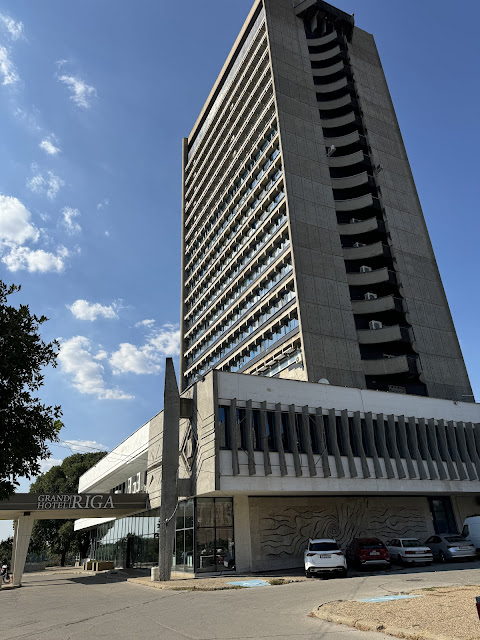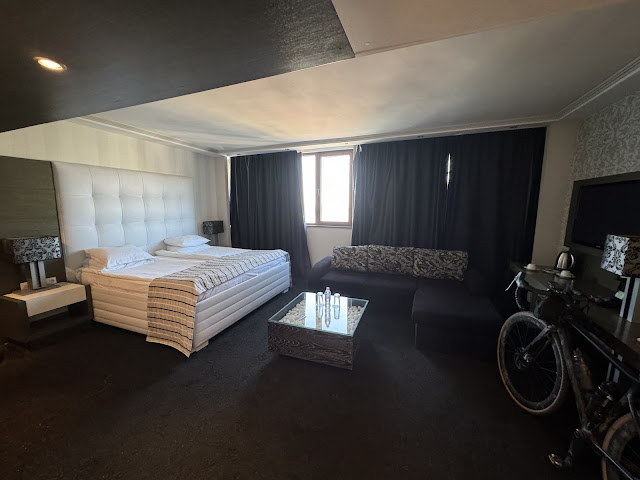Day 12: Corabia to Ruse
Today was, as predicted yesterday, a virtual carbon copy of the previous ride. Baking heat, frequent stops at ProfiLoco stores for liquids, pain and deep suffering…but it would end crossing the Danube for the final time and staying in Bulgaria once again.
Ok, I'm not going to do this one more time. If you're bored of photographs of maize fields, wrinkly old men on horse drawn carts and run down villages baking in the unrelenting heat, imagine how bored I am after three days of this. All you need to do is to read the post from yesterday again but imagine it being hotter and me being a bit more buggered and lacking in energy. You will have completely nailed today.
While you're imagining all that, let's do something a little different. While I'm suffering on the road, why don't we dive into a little bit of the history of Romania and its two most famous sons. Vlad the Impaler and Dracula.
In the 15th century, the region of Wallachia — much of which is current day Romania — was ruled by Prince Vlad II. It wasn't an independent kingdom but was a vassal of the mighty Ottoman Empire. Vlad II was summoned to pay homage to the Sultan Murad and he travelled to Gallipoli with his two younger sons Vlad and Radu. His elder son and heir Mircea remained in Wallachia.
It turned out it was a trap. The Sultan had heard that Vlad II had been fighting on the Christian side against the Ottomans and wanted to punish him. He took away the two younger boys and interned them in a castle as hostages and sent Vlad II back to Wallachia to put him on the naughty step and to “think carefully about what he'd done”.
Years previously, in Nuremberg, Vlad had been inducted into a secret society known as the Order of the Dragon in which each member vowed to fight on the Christian side if any of the others were attacked. Hence Vlad II doing the anti-Ottoman stuff. The word in old Romanian for Dragon is “Dracul” and he passed the title on to his second son Vlad III but with the Romanian dimunutive added and Vlad III became Vlad Dracula.
Vlad Dracula and his younger brother Radu remained in the Ottoman Empire and by all accounts were very well treated. They were well educated alongside the Sultan's son Mehmed and, by some accounts Radu became Mehmed's lover.
The story of the Balkans can be summed up as “eventually it didn't end well for ⟨insert name here⟩” and eventually things didn't end well for Vlad II. He and Mircea were deposed in a palace coup by the boyars (nobles), their bodies were mutilated and buried alive. Vlad Dracula came steaming back from Gallipoli to avenged them, but only managed to retain the throne for 30 days before he had to escape to the wild lands in Transylvania. There he remained for 13 years, hanging around in bars and looking — and acting — a bit like Viggo Mortenson in the Lord of the Rings. Like Aragon, all he had to do was hang around looking sexy and cool and his chance would come. The Prince of Wallachia got tied up fighting yet another Ottoman imperial overreach near Belgrade. While he was otherwise engaged, Vlad Dracula swept down from Transylvanian mountains and fought a brilliant guerrilla campaign which brought the Prince back to defend the throne. Vlad Dracula ambushed him and his party in a forest and fought him single handedly and killed him. There was definitely a lot of swash being buckled. Immediately all the boyars saw which way the wind was blowing, hailed Vlad Dracula as the rightful king and he was installed on the throne.
Vlad knew that the boyars were the ones that had killed his father and brother but he bided his time. 9 months later at a feast celebrating Easter he rounded up all the nobles. Those who had directly participated in his father and brother's deaths he impaled on long birch poles. The ones who weren't directly involved were sent to rebuild a church for a couple of years and then impaled anyway. In Romanian he became known as Vlad Țepeş. Or Vlad the Impaler. Big reveal, Dracula and Vlad the Impaler refer to the same guy.
He was a pretty fierce guy — and is still much admired in Romania to this day.
He was once so annoyed at two ambassadors from the Ottoman Empire who didn't take off their turbans in his presence that he got his guards to nail the turbans to the ambassadors heads. Needless to say, that didn't end well for the ambassadors.
He once invited all the beggars in the capital city to a big feast. They all arrived, started munching on the lovely food only to smell burning. Vlad's soldiers had barred the doors and were burning down the building. Hundreds died but from Vlad's perspective, he had made his views on begging (“as bad a stealing”) very clear.
He is most famous for the retreat he made when Mehmed — the boy who had been his brother's lover succeeded his father and was now the Sultan — decided to invade across the Danube and teach Vlad Dracula a lesson. The Ottomans got across the Danube near to where I am now in Ruse. They had a huge army which outnumbered Vlad's four or five to one but Vlad's retreat was masterful. He would draw his troops back slowly, poisoning all the water, torching crops and every now and then flooding fields so the Ottomans couldn't bring up their cannons due to the mud. He also dragooned the peasants whose crops he had burned and cattle he had slaughtered into digging pits, filling them with spikes and camouflaging them. All the time he was undertaking guerrilla raids to capture Ottoman soldiers or killing them and taking their bodies with him.
Finally, Mehmed's exhausted, hungry and terrorised army approached Vlad's stronghold. They saw what they thought was a forest in the distance but was, in fact, 20,000 of their ex-comrades impaled on giant posts. Mehmed took one look at that and thought “fuck that for a game of soldiers, these guys are mental”. He installed Vlad Dracula's brother Radu on the throne and he went home never to return. This is effectively the foundational story of Romania.
A number of sources suggest that the Romanian predilection for rulers who have strong authoritarian policies is an echo of these times.
Finally, so what's the gig with the blood sucking vampire Dracula? Although Vlad Tepeş was a pretty bad bloke, he was never accused of sucking the blood of attractive young women in diaphanous night dresses. Well…Bram Stoker was an impoverished Irish writer and sometime theatre impresario in the 1890s. He'd noticed that gothic horror stories were doing well in the shops (The Portrait of Dorian Gray, Dr Jekyll and Mr Hyde etc) so he thought he'd try his hand at one. He was idly flicking through some books in the London Library and came across one about Transylvania which mentioned Dracula. He underlined the name twice in the book — which is a very poor form when it comes to library books — and set about writing his book using Dracula's name for the main character. And so there you have it.
I really recommend Paul Kenyon's book The Children of the Night — from which these stories are taken and poorly summarised — for more of this stuff and a whole lot more about the tragic history of Romania.
That history lesson might have been boring but I have spared you detailed descriptions of 7 hours of real suffering. Just like yesterday it was hot — the temperature in Zimnicea at lunchtime was 44 degrees, the roads were long, hot and straight and I was flagging badly. The villages were, if possible, even more run down than the ones I went through yesterday although I did see a bling house who had forgone the traditional Louis Vuitton or Armani and wished to shout to the world that they liked the fashion of Coco Channel.
Apart from that, there was trash absolutely everywhere and a veritable menagerie of road kills ranging from squished birds and snakes, through cats and dogs to — in one never-to-be-erased-from-my-nightmares instance — a fully grown goat which had effectively exploded on the front of a car.
Let's just draw a veil over this entire day until I start to get to the end.
I was going to be crossing into Bulgaria to stay in Ruse (or Pyce as it is in cyrillic). Ruse is across the Danube from the Romanian town of Giurgiu. I had to work my way through Giurgiu and up onto the Friendship Bridge to do what would be my final crossing of the Danube for the trip. I was 140 km into one of the hardest days on a bike…ever…when I started passing the, now familiar, decaying remnants of communist industry. If anybody ever wants to shoot a post-apocalyptic movie, Giurgiu has a lot of great locations.
Once through the “industrial rust and graffiti” doughnut which seems to ring every town, I was then into the “residential wasteland” zone. Most places I have been in the former Warsaw Pact countries, the past 30 years has enabled the government to pull down or renovate the old Soviet era housing. Not in Romania. It's all still inhabited in all its alienating architectural horror.
Giurgiu had thoughtfully installed some cycleways and infrastructure although they had forgotten to tell the populace what the point of cycleways were. Drivers parked on them and cut across them without bothering to look because…lets face it…there was only one mad cyclist in the whole town actually using the cycleways so what was the point?
I stopped in a small bit of shade on the cycleways to check my map. It is yet another golden rule of cycling in temperature conditions like this that if you ever stop the bike, you do it in some shade otherwise you will die. While I was checking my map in the cycleways a young lady in an ancient VW Golf tried to reverse over me as she attempted to park in the cycleway I was on.
After that I just stuck to the roads. At least on the roads you can own your own bit of road and try to dominate the traffic by being as big and loud as possible.
Some pretty hairy and fucked up roads led up onto the bridge approach. Lots of lorries, lots of potholes but the lorries had to go through customs and so it was relatively quiet on the final approaches.
- Distance: 158km. Too long too far not enough interest to get through it.
- Climbing: 547m. Not much but not looking forward to twice this tomorrow.
- Body: Less said about absolutely everything the better. The “stupid middle-aged man” solution to the Achilles tendon problem (“Just ride it out, it'll be fine, grow a pair”) hasn't actually made it worse. The cyclist's palsy in my hands is progressively getting worse. At some stage I won't be able to type these posts.











Puts my cycle ride to Histon in 33° heat today for lunch in perspective. Thanks for the posts!
ReplyDelete